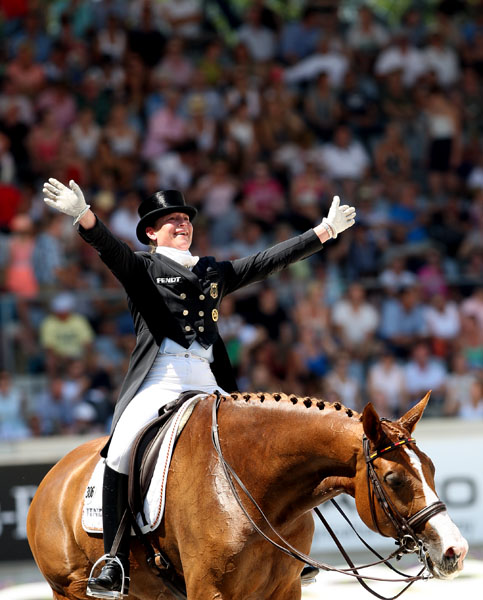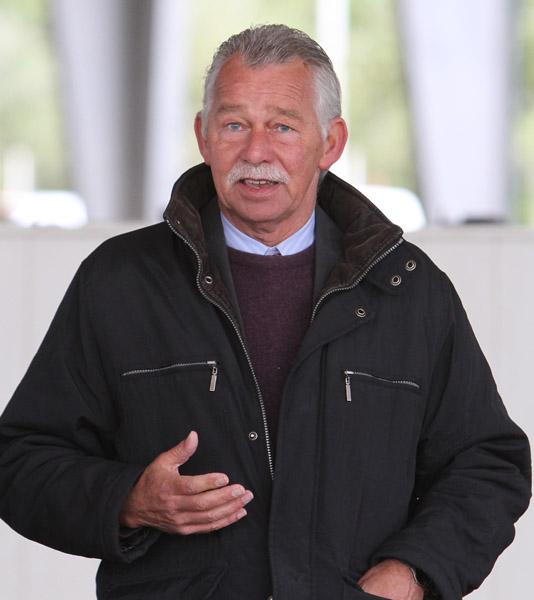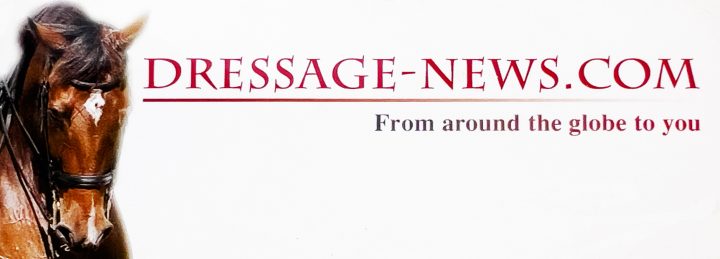Judges & Judging–More of “That’s Dressage (Sigh!)” or Real Change on the Way?
11 years ago StraightArrow Comments Off on Judges & Judging–More of “That’s Dressage (Sigh!)” or Real Change on the Way?

Sept. 4, 2014
By KENNETH J. BRADDICK
With World Equestrian Games dressage over and no major controversies but concerns over judging as widespread as ever, attention is turning to ways to revamp how marks are awarded with high technology and social media likely to play big roles in providing transparency and fairness in scoring for all competitors.
Making scoring transparent and understandable to all as it has in some other jury sports–in gymnastics and ice skating spectators simply had enough and aired their opinions loudly at championships televised around the world–is becoming a priority. Paying judges–as they are in the United States–to make them both professional and accountable is another idea.
On only a few occasions has this correspondent witnessed anything like the jeers directed at ice skating judging. The two most memorable were at the world’s premier horse show, Aachen, Germany. One involved scores of two titans of the sport, Anky Van Grunsven and Isabell Werth, and in 2011 when judges placed Totilas ridden by Matthias Alexander Rath ahead of Ravel ridden by Steffen Peters. The crowd reaction was also a refreshingly honest headline on the event’s news release.
An overhaul of the system is considered by some of the most influential figures in the sport as long overdue.
If judges do not determine marks based on requirements spelled out in detail with illustrations of the International Equestrian Federation (FEI) Dressage Rules then outside elements such as high tech tools or spectators using social media may force them to do so.
Failure to change and soon could find dressage shuffling off the Olympic stage–it’s already near the bottom of International Olympic Committee ratings to keep it in along with the other equestrian sports of eventing and jumping.

Among those working on or actively supporting efforts to find solutions are Frank Kemperman, chairman of the FEI Dressage Committee and show director of the World Equestrian Festival at Aachen; Ullrich Kasselmann, organizer of some major competitions in Germany as well as a founder with Paul Schockemöhle of Performance Sales International, and Ann-Kathrin Linsenhoff, an Olympic gold medalist for Germany, organizer of the prestigious Frankfurt Christmas show and an owner with Paul of Totilas.
Wayne Channon, International Dressage Riders Club secretary general, represents riders typically reluctant to speak out publicly for the obvious reason of fearing to alienate those who sit on the sidelines in judgement, is making a major effort to put the issue at the forefront.
He wants the problem aired at the sport’s annual Global Dressage Forum to be held in Denmark Oct. 20-21.
The results of the team competition at the 2013 European Championships where a score awarded by one judge for one ride may have altered the distribution of medals caused considerable hand wringing.
Beginning next year, a change in tallying up total marks–in its simplest form a disparity of greater than six per cent from the average would be eliminated by changing the errant result to fit into the group’s scores.
That, Wayne Channon said in a conversation with dressage-news.com at the Hickstead, England Nations Cup last month, is a band aid on a long festering problem of the subjective nature of “that’s dressage” judging and lack of accountability.
Some judges acknowledge the issues, too, and want solutions that advance the sport. But that doesn’t stop nationalistic tendencies creeping in to their scoring as they did in Normandy, while some resist a lessening of their power.

Thousands of riders (there are about 700 individual Grand Prix riders alone on the FEI’s world ranking list) compete in dressage on horses worth billions of dollars, invest billions more in personal and competition real estate, the infrastructure of coaching, health and fitness programs for horses and riders, farriers, transportation, accommodation at shows and much more.
This year, about 150 horse shows in more than 35 countries were approved by the FEI, with 23 in the United States, 18 in Germany, 17 in France, nine in the Netherlands, eight in Australia and seven in Austria leading the number of events.
A total of 169 judges were licensed by the FEI, 33 at the 5* level that also means they can judge at Olympics and world championships, 79 at 4*, 43 at 3* and 14 at 2*.
As Stephen Clarke of Great Britain, the FEI Judge General puts it, one approach is to make “professional” membera of the ground jury.
That group is typically five judges for Big Tour competitions, increased to seven for Grand Prix championships such as Olympics, the World Equestrian Games and the Europeans Championships with a three-member Judge’s Supervisory Panel that has the power to make changes to scores in some circumstances.

The fundamental problem with judging as seen by Wayne Channon and others is that judges do not mark in a way that is so transparent, consistent and easily understood by trainers, riders and knowledgeable spectators as well as casual observers who often find the way points are awarded to be incomprehensible.
Favoritism, familiarity and pigeon holing are buzz words considered by many as too oommon when it comes to judging–not the requirement that nothing matters except what is being performed in the competition arena at that particular moment.
Critics of the current system insist that marks should not be awarded on a subjective basis, but fulfill the requirements of the movements as specified in the international rules.
The 33 movements and the four collective marks in a Grand Prix test are clearly defined in the FEI rules (see here). Artistic applies when music is added for Freestyles.
“We could adopt a system similar to gymnastics,” Wayne Channon explained. “Start with a mark of 10–the maximum available. Then make deductions for not performing the requirement of a particular movement the way it is supposed to be performed.”
Take piaffe, where the rules are specific: (“…the height of the toe of the raised forefoot should be level with the middle of the cannon bone of the other supporting foreleg. The toe of the raised hind foot should reach just above the fetlock joint of the other supporting hind leg,” is just one part) If the combination in the arena does not meet that requirement, Wayne said, then deduct, say, a half point.
If the requirement is for 12 to 15 steps of piaffe–movements 8, 15 and 30 all carrying a coefficient of two or twice the number of points in the Grand Prix–but fewer or more are performed, make another deduction. If the horse moves forward more than the rule that says there “may be a visible inclination to advance” then make another deduction. If the horse makes one of the real no-nos and steps back, then deduct a full point.
Spectators, he said, could avidly follow a ride just like they can with lightning fast gymnastics confident that what they see is what’s being judged.
The goal of the dressage riders, Wayne said, is not to impose a particular system but to see how other sports have dealt with judging issues, get ideas about what could work for dressage and adopt a method that fits the sport.
Vitally important, he said, is to make judges accountable.
In this era of high technology that offer instant replays (soccer, American football and tennis are among sports that have embraced technology to help with critical decisions) provide riders the right to challenge marks.
What are some ideas to overhaul judging?
Phone/Tablet App for “Digital CHIO” at Aachen
A phone/tablet app was premiered at the World Equestrian Festival that enabled spectators to judge rides in the dressage competition. Developed by the German software giant SAP and the Aachen organization the app enabled spectators both at the competition, known for its knowledgeable audience, or viewing the Internet streaming television service ClipMyHorse to use a smartphone or tablet to award their own scores. Scores of the judges, the overall result of spectators and the individual’s own marks were updated immediately after each ride.
Spectators had the option to judge as an expert and award a score for each movement or choose a ‘standard version’ and award an overall score after each ride.
Frank Kemperman, FEI Dressage Committee chair and Aachen Show Director, told dressage-news.com the results are being reviewed in preparation for working with SAP on further development.
One addition several spectators, riders and trainers suggested to dressage-news.com was to add a description and animation for each movement so spectators could make even more informed judgements.
Christoph Hess, a wellknown judge and commentator on Aachen’s radio station, tested the app and declared it a potential tool for educating trainers and judges.
Carl Hester, Great Britain’s Olympic team gold medalist who was at Aachen to coach Charlotte Dujardin on Valegro, was more enthusiastic:
“Given the knowledge of the Aachen audience, I suspect most of them were using it in ‘expert’ mode, which lets them mark every movement. This is an interesting innovation and I can quite see how Aachen placings in the future will end up depending on a 50.50 public/judges result.”
See how spectators and the judging panel ranked competitors in the CDIO5* Grand Prix Freestyle–Judging App_Results Deutsche Bank Prize_0720
Electronic-Judge
An even more ambitious and innovative project is a yet to be developed “electronic judge” to measure the accuracy of movements, going beyond earlier ideas of using video cameras mounted on judge’s booths to review performances–instant replay–and how each movement was judged from that particular location.
Ullrich Kasselmann and Ann Kathrin Linsenhoff are underwriting a study by the IIS Fraunhofer Institut based at Erlangen, Germany and a world leader in multimedia research and application development.
The aim is not to monitor the judges or curtail their authority, Ullrich told dressage-news.com. In addition to providing a tool for the judges, the system could be used for training that would provide a worldwide base.

Judges as paid professionals. Judges in Europe typically volunteer their services–a massive commitment of time and loss of earning power. A judge typically spends about four day–three days judging as well as travel to and from shows.
An unofficial study found that the total number of judges required could be cut to about 50, about one-third the current number of officials licensed at 3* or above.
American organizers of international competitions usually pay foreign judges $500 (€385) per day, economy class airfare and a daily allowance for meals. The top shows, such as the Global Dressage Festival in Wellington, Florida pay the same for senior national level judges, less for individuals licensed only for lower levels.
Payment to judges has been a staple of American shows for many years and the higher fees required are considered part of the cost of showing.
However, many European who compete in the U.S. complain about the higher entry costs that raises an issue of how European show organizers could cover the additional expenses.
Paying judges also can have a downside–so-called “Santa Claus” judges who dispense high scores that in turn increases entries to shows where they officiate so they can demand higher fees from the organizer. Inflated results also make a mockery of the U.S. Dressage Federation awards system which is based on scores.

